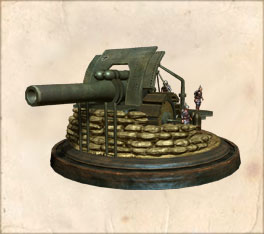
| Action | Price |
|---|---|
| Upgrade | 2000 |
| Sell | 2000 |
| Repar | 400 |
Description[]
"Need something utterly obliterated? So long it's within eight miles, Bertha will take care of it."
Attributes[]
BOOM! Longer reload times.
In the Game[]
This gigantic artillery has an enormous range and, if positioned well, can fire at targets all over the map. It also causes large area damage. Everything in a larger area of the impact is destroyed, with the exception of bosses. However, the gun has a long reload time and the minimum distance that the enemy target must have, because otherwise it is too close, is larger. The crew consists of 6 men.
History[]
Since the targets for such heavy guns were missing after the transition to the position war and the shooting range increasingly proved to be insufficient, new uses for the M-unit's wheel mount were sought. After several variants had been examined, a new tube of 30.5 cm L / 30 caliber was finally inserted into the carriage. The resulting gun was called a heavy kartaune or a β-M device. At the end of the war there were two batteries equipped with this type of gun on the front. With a 333 kg floor and four partial loads, the maximum range was 16.5 km (the use of up to six partial loads was prohibited after several pipe crusher)
At the beginning of the First World War, the gun could be used with great success against the older Belgian and French barrage forts, which were constructed in non-reinforced stamped concrete or were only partially reinforced. The use was particularly devastating for plants that were still largely built in quarry stone such as Fort de Liouville (Apremont-la-Forêt). The fortifications could not withstand the explosive force of the previously unknown caliber.
At the beginning of the war, the Liège fortress ring, consisting of twelve forts, was considered impregnable. Fortunately for the German attackers, the city center of Liège was conquered on August 5, 1914. The twelve surrounding forts could only be taken after the heaviest siege artillery with the caliber 42 cm had been brought in with the Dicken Bertha. When the fat woman bombarded Bert Lon Loncin, she hit the bullet on August 15, 1914. The fort then exploded; 350 Belgian soldiers died.
During the siege of Antwerp in September / October 1914, two batteries (short marine cannon battery 2 and 3) were used, each with two gamma devices. Forts Wavre-Sainte-Catherine and Koningshoyckt were bombarded by battery 2 and Lier, Kessel and Broechem by battery 3.
The mortars were also used at the Verdun theater. Fort Vaux and Fort de Moulainville, among others, were considerably damaged. The massive shelling also destroyed heavily concreted or steel armored parts. After the Verdun use, the pipes were badly worn; No replication was carried out due to the increasing obsolescence of the gun type.
According to the Versailles Treaty, the guns had to be destroyed or handed over to the Allies after the end of the First World War. One of the gamma devices that was on the Krupp test site was overlooked. First used for shooting attempts in 1936/37, it was reintegrated into the army in 1939 and used in World War II. The first mission took place on June 7, 1942 during the siege of the Sevastopol fortress. In September 1944 the gun was used to suppress the Warsaw Uprising. The whereabouts of the gun is unclear.
Gallery[]
Links[]
Trivia[]
- Fun Fact:A gun cost 1 million marks (German currency in imperial times) and was designed for 2,000 rounds. Each shot also cost about 1500 marks (1000 marks ammunition + 500 marks depreciation)
- On the protective shield in the right upper corner (from the front view) there is a iron cross.



